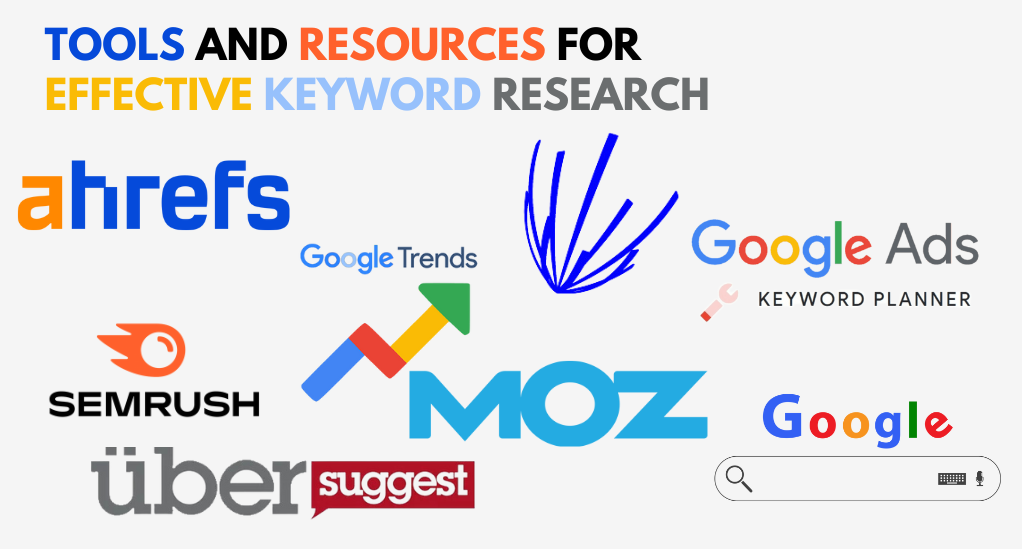How to Conduct Keyword Research for SEO
In the vast digital landscape, where billions of searches occur daily, standing out becomes a challenge. Every business, blogger, and content creator hopes their website will be the one users click on when they type a query into a search engine. But how do you ensure that your content reaches the right audience? The answer lies in effective keyword research.

The Power of Keywords
Imagine the internet as an enormous library. In this library, instead of books, we have websites. Now, if you were to find a specific topic in this vast collection, you’d need an index or a catalog. In the digital realm, this index is created using keywords. Keywords are the terms that users type into search engines when they’re looking for information, products, or services. They are the bridge between the user’s query and the most relevant content on the web.
| Term | Definition |
|---|---|
| Keyword | A word or set of words that users type into search engines. |
| Long-tail Keyword | A longer, more specific keyword phrase that visitors use when they’re closer to the point of purchase or when they’re using voice search. |
| Seed Keyword | The primary term or topic from which other keyword variations stem. |
Why Keyword Research is Crucial
- Understanding Your Audience: Keyword research allows you to dive deep into the minds of your potential audience. By understanding the terms they use, the questions they ask, and the problems they’re trying to solve, you can tailor your content to meet their specific needs.
- Driving Quality Traffic: Not all web traffic is beneficial. By targeting specific keywords relevant to your content, products, or services, you ensure that the visitors to your site are genuinely interested in what you have to offer.
- Staying Ahead of the Competition: In the ever-evolving world of SEO, staying updated with the latest keyword trends can give you a competitive edge. By targeting emerging keywords or filling gaps your competitors have missed, you can carve out a unique space for your brand.
- Optimizing Marketing Spend: For businesses investing in paid advertising, keyword research ensures that your ad budget is spent targeting terms that are most likely to convert.
The Foundation: Asking the Right Questions
Embarking on the journey of keyword research is akin to setting out on a treasure hunt. The treasure, in this case, is a deeper understanding of your audience and the keys to unlocking your website’s potential. But before you start, you must ask the right questions.

Understanding Business Goals and Customer Needs
Every business has a unique set of goals, whether it’s increasing sales, driving website traffic, or building brand awareness. Similarly, every customer has distinct needs and problems they’re looking to solve. The intersection of these business objectives and customer needs is where effective keyword research begins.
Consider the Following Scenarios:
- A local bakery might want to increase foot traffic to their store. Their customers, on the other hand, might be looking for “best chocolate chip cookies near me” or “gluten-free pastries in [city name].”
- An online tech store aims to boost sales of a new gadget. Potential customers might be searching for reviews, comparisons with other products, or tutorials on how to use the gadget.
By identifying these intersections, you can tailor your keyword strategy to target terms that resonate with your audience’s intent and align with your business goals.
The Pitfall of Assumptions
One common mistake in keyword research is making assumptions. Just because you believe a term or phrase is relevant doesn’t mean your audience does. For instance, a business might use industry jargon or brand-specific terms that the general public doesn’t recognize. This disconnect can lead to missed opportunities and wasted efforts.
Example:
| Business Term | Audience Term |
|---|---|
| Cellular device | Mobile phone |
| Footwear | Shoes |
| Beverage | Drink |
Crafting the Right Questions
To bridge the gap between business objectives and audience intent, you must craft the right questions:
- What are our business’s primary goals? (e.g., Increase sales, drive website traffic, build brand awareness)
- Who is our target audience? (e.g., Professionals, students, parents, hobbyists)
- What problems or needs does our audience have? (e.g., Finding affordable products, learning a new skill, discovering local services)
- How might our audience describe their needs in their own words? (This involves thinking from the audience’s perspective and considering the language they might use.)
- What related topics or subtopics could our audience be interested in? (e.g., If you’re selling fitness equipment, related topics might include workout routines, dietary tips, or fitness challenges.)
Deciphering Searcher’s Language
Language is a powerful tool. It’s how we communicate, express ourselves, and seek information. In the realm of SEO, understanding the language of your searchers is paramount. It’s not just about what people are searching for, but how they’re searching for it.
The Evolution of Search Queries
Over the years, the way people search has evolved. With advancements in technology and the rise of voice search, queries have become more conversational. People no longer type fragmented keywords; they ask full-fledged questions.
For instance:
- Then: “best Italian restaurants”
- Now: “What are the best Italian restaurants near me?”
This shift towards natural language search means that businesses need to think beyond simple keywords and consider the context and intent behind search queries.
The Importance of Semantic Search
Google and other search engines have become smarter. They no longer rely solely on exact-match keywords to deliver search results. Instead, they use semantic search to understand the context and intent behind a query. This means that even if a user doesn’t type the exact keyword you’ve targeted, your content can still rank if it’s contextually relevant.
Example:
A user might search for “how to keep indoor plants alive.” Even if you haven’t used this exact phrase in your content, your article titled “Tips for Caring for Houseplants” could still appear in the search results.
Tools to Understand Searcher’s Language
Several tools can help you dive deep into the language of your audience:
- Google’s “People also ask” feature: This provides insights into related questions that searchers are asking, giving you a broader perspective on a topic.
- Google Trends: It shows how search queries change over time, helping you identify emerging trends and terms.
- AnswerThePublic: This tool visualizes search questions and suggests autocomplete searches in a graphical format.
- Forums and Social Media: Platforms like Reddit, Quora, and niche-specific forums can be goldmines for understanding the language, questions, and concerns of your target audience.
Tips for Aligning with Searcher’s Language:
- Create FAQ Sections: Address common questions related to your business or industry. This not only provides value to your audience but also aligns with the trend of question-based searches.
- Use Natural Language: Write content in a conversational tone, as if you’re directly speaking to your audience. This resonates more with voice search queries.
- Optimize for Featured Snippets: These are the boxes you see at the top of Google’s search results that provide direct answers to user queries. By structuring your content correctly and providing clear answers, you can increase your chances of appearing in these snippets.
Discovering Potential Keywords
The heart of any successful SEO strategy lies in the keywords you target. These are the terms and phrases that will connect your content to your audience. But with billions of searches made daily and an ever-evolving digital landscape, how do you pinpoint the right keywords for your business? Let’s explore the art and science of keyword discovery.
Starting with Seed Keywords
Every keyword research journey begins with a seed – a basic idea or topic from which various keyword variations can sprout. Seed keywords define your niche and help you identify your competitors.
For example:
If you run an online store selling handmade candles, your seed keywords might include “handmade candles,” “artisan candles,” and “organic wax candles.”
Expanding with Keyword Research Tools
Once you have your seed keywords, it’s time to expand them into a list of potential keywords. Several tools can assist with this:
- Google Keyword Planner: A free tool by Google that provides keyword ideas and data on search volume, competition, and potential ad spend.
- SEMrush: A comprehensive SEO tool that offers keyword analytics, competitor research, and more.
- Ubersuggest: A tool that suggests a plethora of keyword variations based on your seed keyword.
- Ahrefs’ Keywords Explorer: Provides in-depth keyword data, including search volume, keyword difficulty, and more.
By inputting your seed keywords into these tools, you’ll receive a list of related terms, questions, and phrases that your audience is searching for.
Delving into Long-Tail Keywords
While seed keywords are broad and generic, long-tail keywords are longer, more specific phrases that visitors are more likely to use when they’re closer to making a purchase or decision.
Consider the difference:
- Seed Keyword: “Running shoes”
- Long-Tail Keyword: “Best cushioned running shoes for marathons”
Long-tail keywords often have lower search volumes, but they come with two significant advantages:
- Higher Conversion Rates: Because they’re more specific, they tend to attract a more targeted audience that’s ready to take action.
- Less Competition: Fewer websites are targeting these specific phrases, making it easier to rank for them.
Analyzing User Intent
Behind every search query is a user with a specific intent. They might be looking to purchase a product, find information, or answer a question. By understanding this intent, you can tailor your content to meet the user’s needs.
Typically, user intent falls into one of four categories:
- Informational: The user is looking for information or answers. (e.g., “How do candles work?”)
- Navigational: The user is trying to locate a specific website or page. (e.g., “Yankee Candle store locator”)
- Transactional: The user is ready to buy. (e.g., “Buy lavender scented candles online”)
- Commercial Investigation: The user is comparing products or services before making a purchase. (e.g., “Best scented candles for relaxation”)
By aligning your keywords with the right user intent, you ensure that your content is relevant and valuable to your audience.
Understanding Search Volume and Keyword Difficulty
Navigating the world of keyword research is akin to walking a tightrope. On one side, you have search volume, representing the number of times a keyword is searched for. On the other, you have keyword difficulty, indicating how challenging it will be to rank for that term. Striking the right balance between these two factors is crucial for SEO success.
Decoding Search Volume
Search volume refers to the average number of times a specific keyword is entered into search engines over a given period. It provides insights into the popularity of a keyword and the potential traffic you could receive by ranking for it.
For instance:
- A keyword with a monthly search volume of 50,000 means that, on average, it’s searched 50,000 times a month.
However, high search volume doesn’t always equate to high traffic. It’s essential to consider the user intent behind the keyword and whether it aligns with your content.
Grasping Keyword Difficulty
Keyword difficulty (often abbreviated as KD) is a metric that estimates how hard it would be to rank on the first page of search engine results for a particular keyword. It’s usually measured on a scale from 0 to 100, with higher values indicating more competition.
Several factors influence keyword difficulty:
- Domain Authority of Ranking Pages: If the top-ranking pages for a keyword are authoritative, well-established websites, it will be more challenging to outrank them.
- Content Quality: High-quality, relevant content on the ranking pages can make it harder to compete.
- Backlink Profile: The number and quality of backlinks pointing to the ranking pages can increase keyword difficulty.
- On-Page SEO: How well the ranking pages are optimized for the keyword in question.
The Balancing Act
Targeting keywords with high search volume and low difficulty might seem like the ideal strategy. However, such keywords are rare. More often than not, you’ll need to make trade-offs:
- High Volume, High Difficulty: These are highly sought-after keywords. While they promise significant traffic, they also come with stiff competition. Targeting these requires a robust SEO strategy and patience.
- Low Volume, Low Difficulty: These might not bring in massive traffic, but they’re easier to rank for. They’re especially valuable if they have a high conversion potential.
- High Volume, Low Difficulty: The golden keywords. If you find these, prioritize them, as they offer both traffic and a good chance of ranking.
- Low Volume, High Difficulty: Approach these with caution. The effort required to rank might not justify the potential traffic.
Embracing Long-Tail Keywords
As mentioned earlier, long-tail keywords are longer, more specific phrases. They often have lower search volumes but also lower difficulty. The beauty of long-tail keywords lies in their specificity, which often translates to higher conversion rates. By targeting a combination of broad and long-tail keywords, you can create a well-rounded SEO strategy.
Strategic Keyword Analysis
Once you’ve identified potential keywords, the next step is to analyze them strategically. This involves understanding the broader landscape in which these keywords exist, including competitor performance, seasonal trends, and regional variations. By doing so, you can make informed decisions and refine your SEO strategy for optimal results.
Analyzing Competitors’ Keyword Performance
Understanding what keywords your competitors are ranking for can provide valuable insights. It can help you identify gaps in your own strategy, discover new keyword opportunities, and gauge the competitive landscape.
Steps to Analyze Competitor Keywords:
- Identify Your Main Competitors: Start by listing businesses or websites that offer similar products, services, or content as you.
- Use SEO Tools: Platforms like SEMrush, Ahrefs, or Moz can provide insights into the keywords your competitors are ranking for. Input your competitor’s website and explore their top-performing keywords.
- Spot Gaps and Opportunities: Are there keywords your competitors are ranking for that you aren’t? These could be potential opportunities. Conversely, are there keywords you’re ranking for that your competitors aren’t? These are your strengths.
- Analyze Keyword Relevance: Just because a competitor is ranking for a keyword doesn’t mean it’s relevant to your business. Ensure that any keyword you target aligns with your content and offerings.
Seasonal Trends and Keyword Variations
Some keywords may see fluctuations in search volume throughout the year due to seasonal trends. For instance, “summer dresses” might peak in searches during summer months, while “Christmas recipes” would spike in December.
Using Google Trends: This tool allows you to see the search volume of a keyword over time. By analyzing this data, you can anticipate seasonal spikes and tailor your content strategy accordingly.
Regional Keyword Variations
Language, culture, and regional nuances can influence how people search. A term popular in one region might be less common in another.
For example:
- In the UK, people might search for “holiday deals,” while in the US, they’d look for “vacation deals.”
To cater to regional audiences:
- Use Geo-Specific Keyword Research Tools: Platforms like SEMrush allow you to filter keyword data by country or region.
- Analyze Regional Search Data: Google Analytics can provide insights into where your website traffic is coming from. If you notice a significant audience from a specific region, consider tailoring your keyword strategy to cater to them.
- Consider Local Dialects and Slang: Regional variations in language can influence search behavior. Ensure your content resonates with the local audience’s way of speaking.
Crafting Content that Aligns with User Intent and SERP Expectations
Once you’ve conducted a strategic analysis of your keywords, it’s time to craft content. Remember, it’s not just about including the keyword in your content but ensuring the content matches the user’s intent.
Tips for Crafting Aligned Content:
- Analyze the SERPs: Before writing, input your target keyword into a search engine and analyze the top results. What type of content are they? (e.g., blog posts, product pages, FAQs). This can give you an idea of what search engines deem relevant for that keyword.
- Answer the User’s Query: Ensure your content directly addresses the user’s query or need. If the keyword is a question, provide a clear answer.
- Go Beyond the Surface: Dive deep into the topic. Offer insights, data, examples, and actionable steps. Comprehensive content is more likely to rank and resonate with readers.
Tools and Resources for Effective Keyword Research
In the digital age, the tools at your disposal can make or break your SEO strategy. With the right resources, you can uncover hidden gems, gain insights into your audience’s behavior, and stay ahead of the competition. Let’s delve into the myriad of tools available for keyword research, from the basics to the advanced.

Free Tools for Keyword Discovery
- Google Search: The simplest tool at your disposal. Start typing a keyword, and Google’s autocomplete feature will suggest popular search terms. Additionally, the “People also ask” and “Searches related to” sections can provide further keyword ideas.
- Google Keyword Planner: Originally designed for Google Ads, this tool provides keyword suggestions, search volume data, and competition levels.
- Google Trends: Analyze the popularity of search queries over time, discover seasonal trends, and compare multiple keywords.
- AnswerThePublic: Visualize search questions and get a plethora of keyword ideas based on your seed keyword.
Premium Tools for In-Depth Analysis
- SEMrush: A comprehensive platform offering keyword analytics, domain vs. domain comparisons, and insights into organic competitors.
- Ahrefs: Renowned for its backlink analysis, Ahrefs also boasts a powerful keyword explorer tool that provides search volume, keyword difficulty, and more.
- Moz Pro: With its Keyword Explorer, you can find keyword suggestions, SERP analysis, and track your rankings.
- Ubersuggest: While it offers free features, the premium version provides deeper insights, more keyword suggestions, and content ideas.
Specialized Tools for Specific Needs
- Keywords Everywhere: A browser extension that displays keyword search volume, CPC, and competition data right in your search results.
- Soovle: Get keyword ideas from multiple sources (Google, Bing, Amazon, etc.) in one place.
- KWFinder: Focuses on finding long-tail keywords with low competition.
- Serpstat: Offers keyword research, competitor analysis, and site audit features.
Tips for Maximizing the Value from Each Tool
- Combine Multiple Tools: No single tool can provide all the answers. By using a combination of tools, you can get a more comprehensive view of your keyword landscape.
- Stay Updated: SEO is an ever-evolving field. Tools are regularly updated with new features and data. Ensure you’re using the latest versions and stay informed about new tools in the market.
- Analyze Historical Data: Some tools allow you to see historical keyword data. This can provide insights into how search behavior has changed over time.
- Export and Organize: Most tools allow you to export keyword data. Regularly exporting and organizing this data in spreadsheets can help you track changes, spot trends, and plan your strategy.
Implementing Keywords into Your Content Strategy
Having a list of potential keywords is just the beginning. The real challenge lies in seamlessly integrating these keywords into your content strategy. This ensures that your content not only ranks well in search engines but also resonates with your audience, providing value and driving conversions.
Best Practices for On-Page SEO Optimization
- Title Tag: Your title should be compelling and include your target keyword, preferably towards the beginning. It’s the first thing users see on the search results page, so make it count.
- Meta Description: While not a direct ranking factor, a well-crafted meta description with your keyword can improve click-through rates. It should provide a concise summary of your content and entice users to click.
- URL Structure: Keep URLs short, descriptive, and keyword-rich. For instance, for an article about vegan cake recipes, a URL like “example.com/vegan-cake-recipes” is ideal.
- Header Tags (H1, H2, H3…): Use header tags to structure your content. The H1 should be reserved for the main title, with subsequent headers (H2, H3) used for subheadings. Incorporate keywords naturally.
- Keyword Density: While there’s no fixed “ideal” keyword density, ensure your keyword appears naturally throughout the content. Avoid keyword stuffing, as it can harm readability and SEO.
- Internal and External Links: Link to other relevant content on your site (internal links) and authoritative external sources. This enhances user experience and can boost SEO.
- Image Optimization: Use descriptive file names and alt text for images. If you have an image of a chocolate cake, naming it “chocolate-cake.jpg” with alt text “delicious chocolate cake” is better than a generic “image1.jpg.”
Monitoring Keyword Performance and Making Adjustments
Once your keyword-optimized content is live, it’s essential to monitor its performance. This helps you understand what’s working and where adjustments are needed.
- Use Analytics Tools: Platforms like Google Analytics can provide insights into which keywords are driving traffic, user behavior on your site, and conversion rates.
- Track Keyword Rankings: Tools like SEMrush and Ahrefs can help you monitor how your content is ranking for specific keywords over time.
- Adjust Based on Feedback: If certain keywords aren’t performing as expected, revisit the content. Maybe the user intent wasn’t accurately captured, or perhaps the content needs more depth.
- Stay Updated with Algorithm Changes: Search engine algorithms are continually evolving. Stay informed about updates, as they can impact keyword rankings.
Embracing a Holistic Approach
While keywords are a foundational element of SEO, it’s crucial to embrace a holistic approach. This means:
- Prioritizing User Experience: Fast loading times, mobile optimization, and intuitive site navigation can boost SEO and user satisfaction.
- Creating High-Quality Content: Content should be well-researched, well-written, and provide genuine value to the reader.
- Building Backlinks: Quality backlinks from authoritative sites can significantly boost your SEO efforts.
Conclusion
In the dynamic realm of SEO, understanding and adapting to the ever-changing landscape is paramount. At its core, keyword research is about comprehending the needs of your audience and crafting content that resonates. While keywords serve as the foundation, a holistic approach that encompasses site speed, user experience, and continuous learning is vital for sustained success.
As you embark on your SEO journey, remember that it’s not just about data and rankings, but about forging genuine connections with your audience. Embrace a mindset of continuous growth, seek feedback, and stay updated with industry trends. By doing so, you position yourself not just to navigate the digital cosmos but to truly shine within it.


Leave a Reply